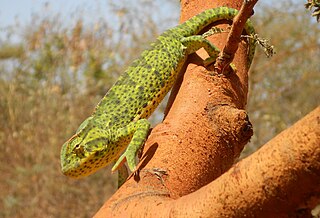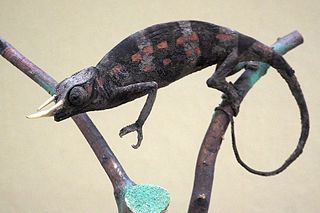
Chameleons or chamaeleons are a distinctive and highly specialized clade of Old World lizards with 202 species described as of June 2015. These species come in a range of colours, and many species have the ability to change colour.

The veiled chameleon is a species of chameleon native to the Arabian Peninsula in Yemen and Saudi Arabia. Other common names include cone-head chameleon and Yemen chameleon. Males grow to around 17-24 inches in length and females around 14 inches, they grow casques on their head and are born as pastel green before growing stripes and more colorful as they grow. They are known for their variable color changes due to a variety of factors, including to show aggression, social status, reproduction, and stress. Females live around 5 years and males live for around 8 and they breed a few times a year.

Jackson's chameleon, Jackson's horned chameleon, three-horned chameleon, or Kikuyu three-horned chameleon is a species of chameleon native to East Africa, but also introduced to Hawaii, Florida, and California.

The Indian chameleon is a species of chameleon found in Sri Lanka, India, and other parts of South Asia. Like other chameleons, this species has a long tongue, feet that are shaped into bifid claspers, a prehensile tail, independent eye movement, and the ability to change skin colour. They move slowly with a bobbing or swaying movement and are usually arboreal. Strangely, they do not choose the background colour and may not even be able to perceive colour differences. They are usually in shades of green or brown or with bands. They can change colour rapidly and the primary purpose of colour change is for communication with other chameleons and for controlling body temperature by changing to dark colours to absorb heat.

The common chameleon or Mediterranean chameleon, together with the African chameleon, C. africanus, is one of only two extant species of Chamaleonidae with a range that extends into Europe.

The coarse chameleon, Trioceros rudis, also known as the rudis chameleon, Ruwenzori side-striped chameleon or the Rwenzori bearded chameleon is a chameleon from western Uganda, Rwanda, Burundi, and eastern DR Congo. Contrary to common belief, this species does not inhabit Mount Meru, Tanzania. Tanzania chameleons called T. rudis are in fact T. sternfeldi.

The flap-necked chameleon is a species of arboreal chameleon, a lizard in the family Chamaeleonidae. The species is native to sub-Saharan Africa. There are eight recognized subspecies, including the nominotypical subspecies.

The Angel's chameleon, initially described as Chamaeleo angeli, is a species of chameleon, a lizard in the family Chamaeleonidae. The species is endemic to Madagascar, and was originally described by Édouard-Raoul Brygoo and Charles Antoine Domergue in 1968.

Furcifer balteatus, also known as the two-banded chameleon or the rainforest chameleon, is a species of chameleon that is endemic to Madagascar. It was described by André Marie Constant Duméril and Gabriel Bibron in 1851.

Furcifer belalandaensis, also commonly known as the Belalanda Chameleon or the Sangoritan'i Belalanda, is a species of chameleon that is endemic to Madagascar. It was identified and described by Édouard-Raoul Brygoo and Charles Domergue in 1970. The International Union for Conservation of Nature rated this species as Critically Endangered on their Red List of Threatened Species. The World Wide Fund for Nature is trying to save this species from extinction.

The Petter's chameleon is a species of chameleon, which is endemic to northern Madagascar. Furcifer petteri was initially described as the subspecies Chamaeleo willsii petteri by Édouard-Raoul Brygoo and Charles Domergue in 1966, but later transferred to the genus Furcifer and given full species status by Frank Glaw and Miguel Vences in 1994.

The Arabian chameleon is a species of chameleon native to the southern Arabian Peninsula. During the monsoon season, they turn green.

The Senegal chameleon, Chamaeleo senegalensis, is a species of chameleon native to West Africa. Its range includes Senegal, Mali, Nigeria, and Cameroon, and it lives in moist savanna. Due to its wide range and unknown population, the Senegal chameleon is listed as Least Concern by the IUCN Red List. However, it may be threatened by the pet trade. The Senegal chameleon is usually olive brown, and ranges from 20 to 30 cm in length, although the male is usually smaller.

The African chameleon or Sahel chameleon is a species of chameleon native to the Sahel and Nile Valley, with an introduced population present in Greece. An average size may be around 34 cm (13 in) long, including its tail.

The graceful chameleon is a species of chameleon native to sub-Saharan Africa. It is commonly around a foot long. Because of its abundance, it is heavily exploited by the pet trade.

The Smooth chameleon is a species of chameleon native to Africa. It is bluish-green and has small scales. Its body is very slender, and it looks similar to Chamaeleo senegalensis.

Owen's chameleon, also commonly known as Owen's three-horned chameleon, is a species of chameleon in the family Chamaeleonidae. The species is native to sub-Saharan Africa. Named after William Fitzwilliam Owen, who was a British naval officer and explorer, it was first described in 1831 by the naturalist John Edward Gray, and is the type species of the genus Trioceros.
Chamaeleo calcaricarens is a species of chameleon found in Ethiopia, Eritrea, Djibouti, and Somalia.
Chamaeleo necasi, also known as Necas's chameleon, is a species of chameleon found in Togo and Benin.
















